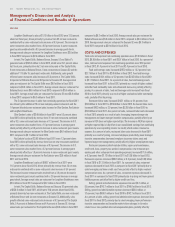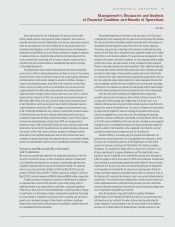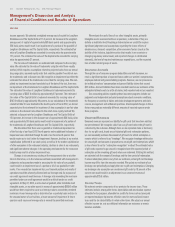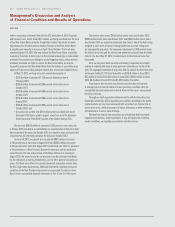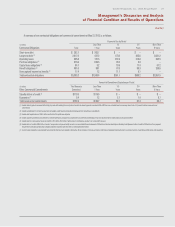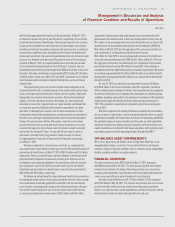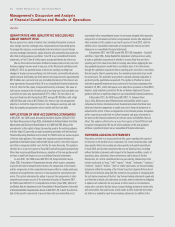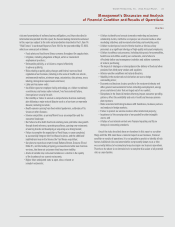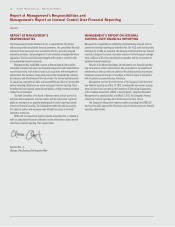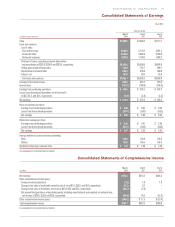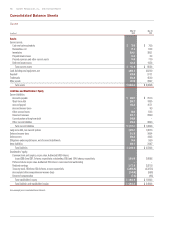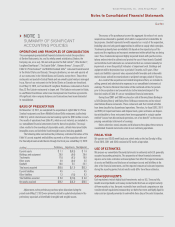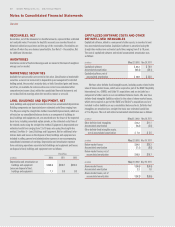Red Lobster 2012 Annual Report Download - page 34
Download and view the complete annual report
Please find page 34 of the 2012 Red Lobster annual report below. You can navigate through the pages in the report by either clicking on the pages listed below, or by using the keyword search tool below to find specific information within the annual report.
Management’s Discussion and Analysis
of Financial Condition and Results of Operations
Darden
30 Darden Restaurants, Inc. 2012 Annual Report
QUANTITATIVE AND QUALITATIVE DISCLOSURES
ABOUT MARKET RISK
We are exposed to a variety of market risks, including fluctuations in interest
rates, foreign currency exchange rates, compensation and commodity prices.
To manage this exposure, we periodically enter into interest rate and foreign
currency exchange instruments, equity forwards and commodity instruments for
other than trading purposes (see Notes 1 and 10 to our consolidated financial
statements, in Part II, Item 8 of this report, incorporated herein by reference).
We use the variance/covariance method to measure value at risk, over time
horizons ranging from one week to one year, at the 95 percent confidence level.
At May 27, 2012, our potential losses in future net earnings resulting from
changes in foreign currency exchange rate instruments, commodity instruments,
equity forwards and floating rate debt interest rate exposures were approximately
$57.9 million over a period of one year (including the impact of the interest rate
swap agreements discussed in Note 10 to our consolidated financial statements
in Part II, Item 8 of this report, incorporated herein by reference). The value at
risk from an increase in the fair value of all of our long-term fixed rate debt, over
a period of one year, was approximately $127.1 million. The fair value of our
long-term fixed rate debt during fiscal 2012 averaged $1.85 billion, with a high
of $2.04 billion and a low of $1.55 billion. Our interest rate risk management
objective is to limit the impact of interest rate changes on earnings and cash
flows by targeting an appropriate mix of variable and fixed rate debt.
APPLICATION OF NEW ACCOUNTING STANDARDS
In May 2011, the FASB issued Accounting Standards Update (ASU) 2011-04,
Fair Value Measurement (Topic 820), Amendments to Achieve Common Fair Value
Measurement and Disclosure Requirements in U.S. GAAP and IFRS. Many of the
amendments in this update change the wording used in the existing guidance
to better align U.S. generally accepted accounting principles with International
Financial Reporting Standards and to clarify the FASB’s intent on various aspects
of the fair value guidance. This update also requires increased disclosure of
quantitative information about unobservable inputs used in a fair value measure-
ment that is categorized within Level 3 of the fair value hierarchy. This update is
effective for us in our first quarter of fiscal 2013 and will be applied prospectively.
Other than requiring additional disclosures, adoption of this new guidance will
not have a significant impact on our consolidated financial statements.
In June 2011, the FASB issued ASU 2011-05, Comprehensive Income
(Topic 220), Presentation of Comprehensive Income, which requires companies
to present the total of comprehensive income, the components of net income,
and the components of other comprehensive income either in a single continuous
statement of comprehensive income or in two separate but consecutive state-
ments. This update eliminates the option to present the components of other
comprehensive income as part of the statement of equity. In December 2011,
the FASB issued ASU 2011-12, Comprehensive Income (Topic 220), Deferral of
the Effective Date for Amendments to the Presentation of Reclassifications of Items Out
of Accumulated Other Comprehensive Income in ASU 2011-05, to defer the effective
date of the specific requirement to present items that are reclassified out of
accumulated other comprehensive income to net income alongside their respective
components of net income and other comprehensive income. We adopted all
other provisions of this update in our fourth quarter of fiscal 2012, with the
addition of our consolidated statements of comprehensive income and other
changes to our consolidated financial statements.
InSeptember2011,theFASBissuedASU2011-08,Intangibles–Goodwill
and Other (Topic 350), Testing Goodwill for Impairment, which permits an entity
to make a qualitative assessment of whether it is more likely than not that a
reporting unit’s fair value is less than its carrying value before applying the two-
step goodwill impairment model that is currently in place. If it is determined
through the qualitative assessment that a reporting unit’s fair value is more likely
than not greater than its carrying value, the remaining impairment steps would
be unnecessary. The qualitative assessment is optional, allowing companies to
go directly to the quantitative assessment. This update is effective for annual
and interim goodwill impairment tests performed in fiscal years beginning after
December15,2011,whichwillrequireustoadopttheseprovisionsinfiscal2013;
however, early adoption is permitted. We do not believe adoption of this new
guidance will have a significant impact on our consolidated financial statements.
In December 2011, the FASB issued ASU 2011-11, Balance Sheet
(Topic 210), Disclosures about Offsetting Assets and Liabilities, which requires
companies to disclose information about financial instruments that have been
offset and related arrangements to enable users of its financial statements to
understand the effect of those arrangements on its financial position. Companies
will be required to provide both net (offset amounts) and gross information in
the notes to the financial statements for relevant assets and liabilities that are
offset. This update is effective for us in our first quarter of fiscal 2014 and will
be applied retrospectively. We do not believe adoption of this new guidance
will have a significant impact on our consolidated financial statements.
FORWARD-LOOKING STATEMENTS
Statements set forth in or incorporated into this report regarding the expected
net increase in the number of our restaurants, U.S. same-restaurant sales, total
sales growth, diluted net earnings per share growth, and capital expenditures
in fiscal 2013, and all other statements that are not historical facts, including
without limitation statements with respect to the financial condition, results of
operations, plans, objectives, future performance and business of Darden
Restaurants, Inc. and its subsidiaries that are preceded by, followed by or that
include words such as “may,” “will,” “expect,” “intend,” “anticipate,” “continue,”
“estimate,” “project,” “believe,” “plan” or similar expressions, are forward-looking
statements within the meaning of the Private Securities Litigation Reform Act of
1995 and are included, along with this statement, for purposes of complying with
the safe harbor provisions of that Act. Any forward-looking statements speak only
as of the date on which such statements are made, and we undertake no obligation
to update such statements for any reason to reflect events or circumstances
arising after such date. By their nature, forward-looking statements involve risks
and uncertainties that could cause actual results to differ materially from those
set forth in or implied by such forward-looking statements. In addition to the


